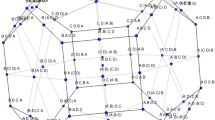Abstract
A group decision-making approach can be seen as a two stage process. The first stage allows for multi-cirteria evaluation of the alternatives and the second aims at deriving a collective weak ordering from the partial orderings supplied by the members after the first stage. The problem of combining the weak orderings to form a collective ranking is investigated. An axiomatic structure relating to the concept of distance between binary relations is developed. An algorithm for deriving the collective weak ordering is proposed, based on the idea of ranking first the least dominated alternatives.
Similar content being viewed by others
References
Armstrong, R. D.,W. D. Cook, and L. M. Seiford. (1982). “Priority Ranking and ConsensusFormation, ” Management Science 28, 638–648.
Arrow, K. J. (1951) (2nd edition 1963). Social Choiceand Individual Values. New York: Wiley.
Blin, J. M. (1976). “A Linear Assignment Formulation for theMultiattribute Decision Problem, ” RAIRO 10, 21–32.
Bogart, K. P. (1975). “Preference Structures II:Distance Between Transitive Preference Relations, ” Journal of Applied Mathematics 29, 254–262.
Borda, J.-Ch. (1781). Mémoire sur les élections au scrutin. Paris: Mémoires de l'Académie des Sciences.
Brans, J. P., B. Mareshal, and Ph. Vincke. (1984). “PROMETHEE: A New Family of Outranking Methods in Multicriteria Analysis, ” in J. P. Brans (ed.), Operational Research’ 84. North-Holland: Elsevier Science Publishers, pp. 408–421.
Condorcet, M. J. A. M., and Marquis De Caritat. (1785). Essai sur l'application del'analyse à la probabilité des décisions rendues à la pluralité des voies. Paris: Imprimerie Royale.
Cook, W. D.,M. Kress, and L. M. Seiford. (1986a). “An Axiomatic Approach to Distance on Partial Ordering, ” RAIRO 10, 115–122.
Cook, W. D., M. Kress, and L. M. Seiford. (1986b). “Information and Preference in Partial Orders:A Bimatrix Representation, ” Psychometrika 51, 197–207.
Cook, W.D., and L. M. Seiford. (1978). “Priority Ranking and Consensus Formation, ”Management Science 24, 1721–1732.
Coughlan, B. A. K.,and C. L. Armour. (1992). “Group Decision-Making for Natural Resources Management Applications, ” Resource Publication 185, U.S. Department of the Interior, Fish and Wildlife Service.
Kemeny, J. G., and L. J. Snell.(1962). “Preference Ranking: An Axiomatic Approach, ” in Mathematical Models in the Social Sciences. New York: Ginn, pp. 9–23.
Roy, B. (1978). “ELECTRE III: algorithme de classement basé sur une représentationfloue des préferences en présence de critères multiples, ” Cahiers du CERO 20, 3–24.
Roy, B., and J.C. Hugonnard. (1982). “Classement des prolongements de métro en banlieue parisienne (presentation d'une méthode originale), ” Cahiers du CERO 23, 153–171.
Roy, B., and R. Slowinski. (1993). “Criterion ofDistance Between Technical Programming and Socio-Economic Priority, ” RAIRO 27, 45–60.
Author information
Authors and Affiliations
Rights and permissions
About this article
Cite this article
Ben Khelifa, S., Martel, JM. A Distance-Based Collective Weak Ordering. Group Decision and Negotiation 10, 317–329 (2001). https://doi.org/10.1023/A:1011257109771
Issue Date:
DOI: https://doi.org/10.1023/A:1011257109771




